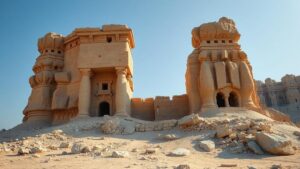Searching for cities hidden within rocky outcrops of desolate mountain ranges.
Searching for Cities Hidden Within Rocky Outcrops of Desolate Mountain Ranges
Amidst the staggering height of mountainous terrains and the rugged beauty of rocky outcrops lie cities that for many, remain hidden gems. These urban areas, steeped in history and culture, are often difficult to access and overshadowed by their dramatic geological surroundings. But, they contribute significantly to our understanding of human adaptation in challenging environments. This article explores noteworthy cities located within or near desolate mountain ranges, shedding light on their unique characteristics and historical significance.
The Intriguing City of La Paz, Bolivia
La Paz stands as one of the most iconic cities set against the backdrop of the Andes Mountains. Located at an altitude of approximately 3,650 meters (11,975 feet), it is the world’s highest capital city. Despite its harsh climate and steep inclines, La Paz boasts a population of over 800,000 residents, who have created a vibrant urban culture.
The city is a remarkable example of human resilience, marked by terraced agriculture that has existed for centuries. surrounding rocky outcrops provide both a natural defense and a source of building materials, leading to the construction of unique adobe houses. The rich history of La Paz is intertwined with ancient cultures, such as the Aymara, who utilized these mountainous terrains long before Spanish colonization in the 16th century.
Exploring the Ancient City of Petra, Jordan
Known as the “Rose City†for its stunning rock-cut architecture, Petra is iconic, situated in the rugged mountains of southern Jordan. Established as early as 5th century BC by the Nabataeans, Petra showcases their impressive engineering skills, with buildings carved directly into the rose-hued cliffs.
The city flourished as a trading hub, linking the silk and spice routes between Europe, Arabia, and Asia. Today, it attracts over 1 million visitors annually, making it one of the New Seven Wonders of the World. The rich historical context and architectural marvels buried within these rocky outcrops make Petra a lasting testament to human endeavor in a harsh environment.
Shadows Cast by the Rocky Walls of Machu Picchu, Peru
Machu Picchu, often referred to as the “Lost City of the Incas,†rests at an elevation of 2,430 meters (7,970 feet) in the Andes Mountains. This UNESCO World Heritage site is famous for its sophisticated dry-stone construction and the breathtaking terraces carved into the mountain.
Discovered in 1911 by American historian Hiram Bingham, this ancient city likely served as a royal estate or religious site. strategic location of Machu Picchu ensures that it remains sheltered from the harsh effects of weather while providing a panoramic view of the Sacred Valley. In 2019, it thrived with over 1.5 million visitors, underscoring its global allure and the ongoing fascination with ancient civilizations adapting to challenging landscapes.
The Importance of Preservation and Tourism
As cities like La Paz, Petra, and Machu Picchu continue to attract tourists, the delicate balance between conservation and tourism becomes crucial. The rise in visitor numbers has often led to environmental degradation and the degradation of local cultures. For example, the increasing foot traffic at Machu Picchu has prompted the Peruvian government to implement visitor caps to preserve the site’s integrity.
Strategies for Sustainable Tourism
To address these concerns, several strategies have been adopted to promote sustainable tourism, including:
- Useing strict visitor regulations and caps.
- Encouraging the use of guided tours to minimize impact.
- Investing in infrastructure that supports both tourism and preservation.
Conclusion: A Journey Through Desolation
Searching for cities nestled within rocky outcrops illustrates humanity’s tenacity in the face of geographical challenges. Exploring places like La Paz, Petra, and Machu Picchu reveals not only the architectural feats of past civilizations but also the intricate relationship between nature and urban life. As we continue to unearth and study these hidden cities, we are reminded of our responsibility to preserve the beauty and history they embody for future generations.
So, anyone intrigued by the allure of hidden cities in desolate mountain ranges is encouraged to embrace sustainable practices, whether through tourism or community engagement, to safeguard these treasures against the ravages of time and change.


